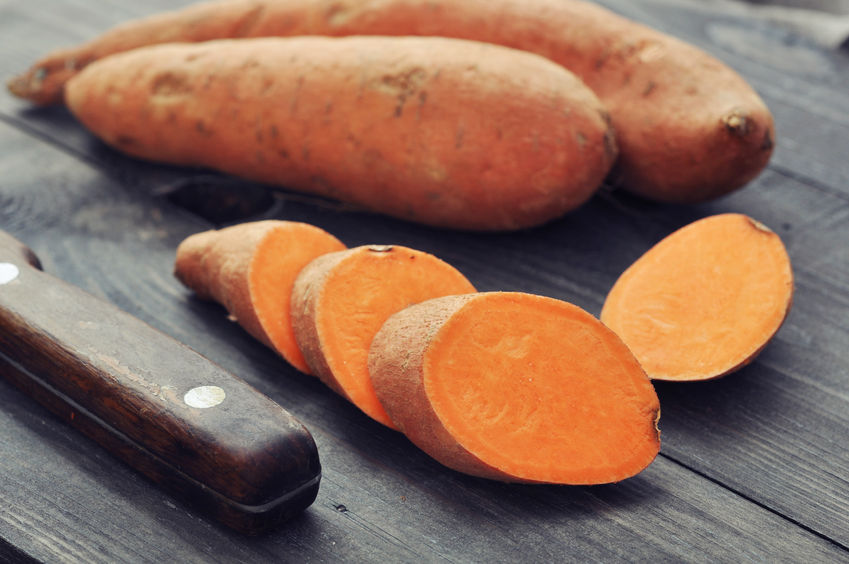Fall is quickly approaching, and that means the menu is about to change. Are you ready for apple cider lager and pumpkin-flavored—well, pumpkin-flavored everything? It’s coming. One of the most underutilized flavors of the season, though, just happens to be my favorite — hats off to the sweet potato, fall’s unsung hero.
Have you been only buying sweet potatoes around Thanksgiving, pouring in loads of brown sugar and marshmallows and calling it good? (There is nothing wrong with that recipe, by the way. It’s as popular as it is delicious.) There are, however, so many more options for the vegetable that don’t compromise its nutritional value.
Nutrition
That nutritional value of the sweet potato is, in fact, very high. The deep orange color indicates that sweet potatoes are high in beta carotene, which is converted by your body into Vitamin A. Sweet potatoes are so high in Vitamin A, actually, that you can reach your recommended daily allotment of the nutrient by consuming only one medium sweet potato. The powerful antioxidant helps keep your teeth, bones, skin and, eyes healthy.
Sweet potatoes also contain loads of Vitamin C, Vitamin B-6 and potassium. Packed with fiber, they’ll leave you feeling full without feeling weighed down. In addition, sweet potatoes are naturally fat-free and won’t cost you that much on the calorie front: half of a large sweet potato has about 80 calories.
Price
You can buy sweet potatoes at the grocery store in any season and they won’t break the bank, but fall is the time to score big. Whether you hit the farmer’s market or a chain grocer, sweet potatoes are one of the cheapest and most versatile fall harvest vegetables. In fact, they make almost every list of inexpensive, healthy vegetables out there. You can usually score at least a couple of them for less than a dollar, at least in my neck of the woods.
Usage
So, you’re convinced that adding sweet potatoes to your diet this fall is a good move. Now what? There are many ways to effectively cook a sweet potato.
Bake it. Line a baking sheet with foil. Bake the sweet potato at 400° until tender, about 45 minutes or longer for multiple potatoes. (When you can easily pierce it with a fork, it’s done.) Instead of butter and sugar, try instead topping the sweet potato with a sprinkle of cinnamon.
Steam it. You can use boiling water and a steamer pot, or you can use the microwave. I tend to run short on time, so I tend to purchase microwavable steaming bags. Simply place the sweet potato (whole or cut) into the bag and put it in the microwave for the time specified on the package. Voila.
Boil it. Fill the pan with just enough water to cover the sweet potatoes and boil until they’re soft. You can add a dash of salt to the water if you wish.
Slow-cook it. If you can’t be bothered with baking or steaming a sweet potato, you can toss a few into your slow cooker before heading out the door in the morning. Simply set the controls to “low” for 6-8 hours. When you come back, you’re sweet potato is soft and cooked through. It really is that easy.
Mix it in. This is my favorite. Once you’ve used one of the above methods to cook your sweet potatoes, you can certainly just eat the result. However, you can also scoop out the orange interior (or keep the peeling—up to you) and add it to other recipes. Try adding cooked sweet potatoes to your scrambled eggs. When formed into breakfast burritos using whole-wheat tortillas, these easy and uber-healthy grab-and-go breakfasts are versatile and can even be frozen for later. This recipe is one example, but the options are endless. Try adding mushrooms, edamame, beans, etc.
Bonus: Make fries. Sweet potato fries are every bit as delicious as those made with white potatoes. If you have a tool that can create spirals from vegetables, you can even make savory curly sweet potato fries with only a handful of ingredients. (If you can’t make spirals, just cut your sweet potatoes into the desired width.) Want to know a trick? If you want a fry that’s a little sweeter, try substituting the olive oil for coconut oil (or a combination of coconut oil and organic maple syrup) and keep the sea salt. Now, you’ve got sweet and savory covered without the guilt.


















